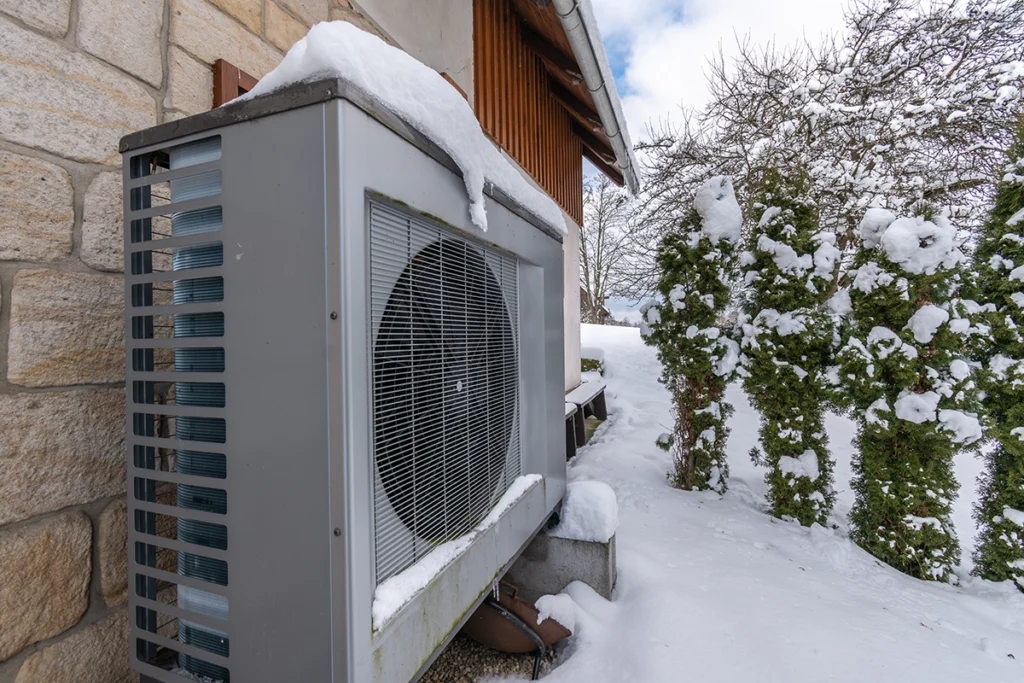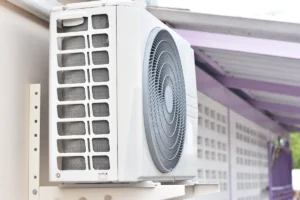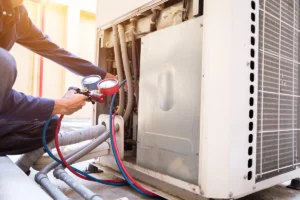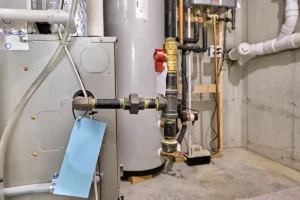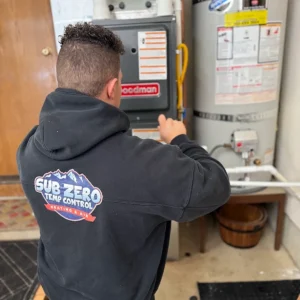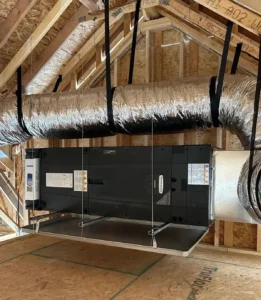A common question I hear is, what is EM heat? (And no, it doesn’t mean “extra magic” heat — though some customers have guessed that before.) Homeowners usually spot that little switch on their thermostat and wonder if something’s wrong with their system. The truth is, EM — or “emergency heat” — is a backup setting on many heat pump systems. It’s not something you want to use every day, but it’s worth knowing what it does and when it can help.
What Is EM Heat and Why Does It Exist?
Think of EM heat as a backup plan. Normally, a heat pump pulls warmth from the outdoor air and transfers it inside. That works surprisingly well most of the year, but when the temperature outside drops too low, or the heat pump malfunctions, it can struggle.
In those moments, EM heat steps in. The system bypasses the heat pump and turns on electric heating coils or a gas furnace backup. The heat feels the same coming through your vents, but behind the scenes it’s a very different process.
When Should You Actually Use It?
This is the part homeowners really want to know. You don’t turn on EM heat just because it’s chilly outside. Instead, you use it when:
Your heat pump isn’t producing warm air.
The outdoor temperature is so cold that the pump can’t keep up.
A technician tells you to switch it on until repairs are made.
The main thing to remember is that emergency heat burns through energy much faster than your heat pump (your utility bill will remind you quickly if you forget).
What Is EM Heat on a Thermostat?
Most thermostats with heat pumps have a setting labeled “EM Heat.” When you select it, the thermostat tells the system to ignore the heat pump entirely and pull heat from its backup source.
That’s a manual decision — the thermostat won’t automatically make the switch for you. So if you ever wonder why your home feels cold even with the system running, you may need to flip that setting until help arrives.
A Few Real-Life Signs You Might Need EM Heat
From what I’ve seen in the field, these are the telltale signs:
The system is running, but the house stays cold.
Ice storms or freezing weather hit and your pump struggles.
You’ve scheduled a repair and need temporary heat.
Common Misconceptions About EM Heat
A lot of homeowners misunderstand what EM heat actually does. Some think it’s “extra heat” that makes the system warmer than usual. Others believe it’s a setting you should use whenever the temperature drops below freezing. Neither is true.
In reality, EM heat isn’t a boost — it’s a backup. It doesn’t provide “super heat” or comfort beyond what your system normally delivers. And it should never be used just because the weather feels cold. Running it unnecessarily can cause utility bills to skyrocket.
The Cost Factor of Emergency Heat
Here’s the tradeoff: EM heat works quickly, but it’s expensive (if we haven’t already hammered this home). Electric resistance heating (which EM heat usually relies on) is 100% efficient in turning electricity into heat, yet because of energy losses in generation and transmission, it ends up costing more. According to the U.S. Department of Energy, using a heat pump can often cut electricity usage by up to 50% in winter compared to pure electric resistance heating.
Seasonal Use in Emergencies
During extreme winter storms, your heat pump may struggle to keep up. That’s where EM heat comes in — it acts as a built-in backup for your HVAC system. If the outdoor unit ices over or temperatures fall too low, switching to emergency heat keeps your home comfortable until the heat pump can recover or a technician can make repairs.
It’s important to note, though, that EM heat only works if your home still has electricity. In a full power outage, neither the heat pump nor emergency heat will run. That’s when you’d need another backup source, such as a generator, wood stove, or propane heater. Resources like Ready.gov’s winter safety tips recommend planning ahead so you have options in both situations.
What Is EM Heat vs. Auxiliary Heat?
This part causes a lot of confusion. Auxiliary heat is automatic — your system kicks it on when the heat pump needs a little help. Emergency heat, on the other hand, is manual. You decide when to switch it on, and the system stops using the heat pump altogether.
Same backup elements, different triggers.
How to Reduce Reliance on Emergency Heat
If you want to avoid high energy costs, the goal is to keep EM heat as a last resort. Here are a few ways to do that:
Schedule seasonal maintenance. Clean filters, tuned refrigerant levels, and clear coils help the heat pump perform better.
Seal air leaks. Drafty windows and doors make your system work harder. Sealing them reduces stress on your pump. For more homeowner-friendly guidance, ENERGY STAR’s heating and cooling tips explain simple ways to improve efficiency and lower bills.
Set a steady temperature. Constantly changing the thermostat can trigger unnecessary heating cycles. A steady setting is more efficient.
Know your system’s limits. If your unit is old or undersized, it may be time to look into a heat pump replacement that’s better matched to your home.
Why Maintenance Reduces the Need
If you’ve kept up with tune-ups, you might never need to flip the EM heat setting. Dirty filters, low refrigerant, or frozen coils often cause unnecessary reliance on backup heat. A seasonal checkup keeps your system running smoothly, which means emergency heat stays in your back pocket for true emergencies.
Quick FAQs About EM Heat
Is EM heat bad for my system?
No, but it’s costly. The system is designed for it, though you shouldn’t use it constantly.
Does EM heat provide more warmth than normal heat?
Not really — the air feels the same, it just comes from a less efficient source.
What if my EM heat isn’t working?
That’s a sign your backup system needs repair. A technician should inspect it right away.
Contact Sub Zero Temp Control
If you’re still unsure about how or when to use emergency heat, we can walk you through it. At Sub Zero Temp Control, we help homeowners understand their systems and keep them running efficiently. Contact us today to schedule a service visit and get ahead of winter problems before they leave you shivering.
Final Thoughts
So, what is EM heat? It’s your heat pump’s manual backup setting — reliable when you need it, but costly if you overuse it. The more you understand how it works, the easier it is to make the right call when the weather turns harsh. And with proper maintenance, you may not have to rely on it much at all.
If you have questions or need help in the Vancouver, WA area, contact us at Sub Zero Temp Control. We’ll make sure you stay warm, no matter how cold it gets.


